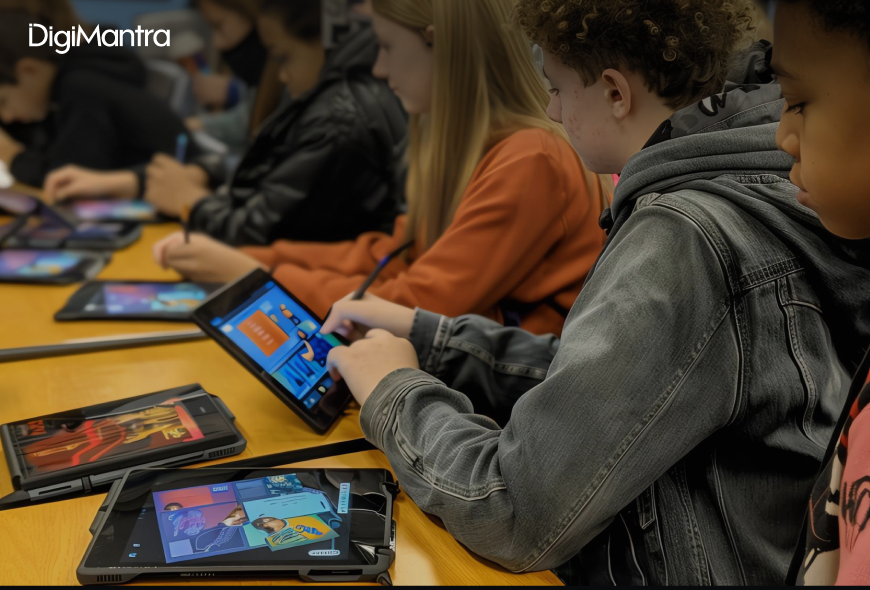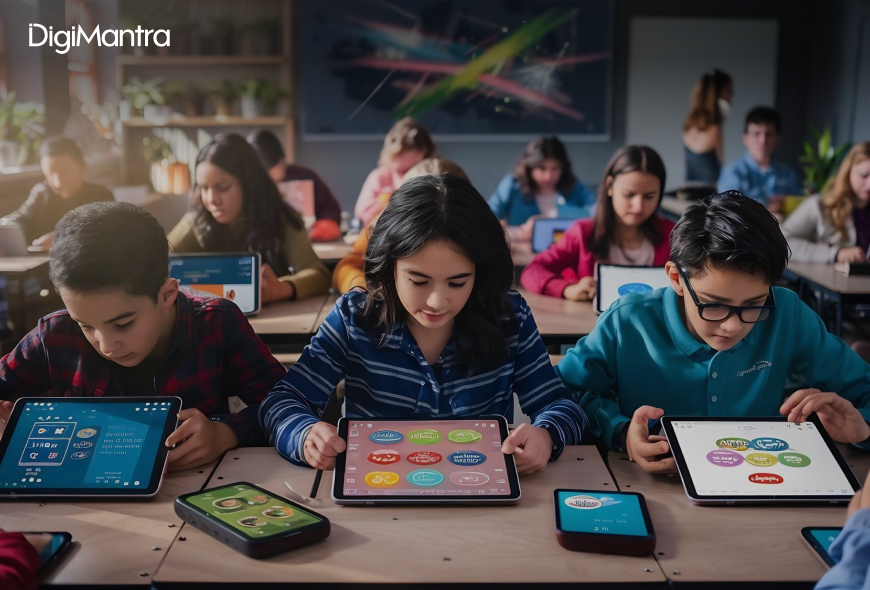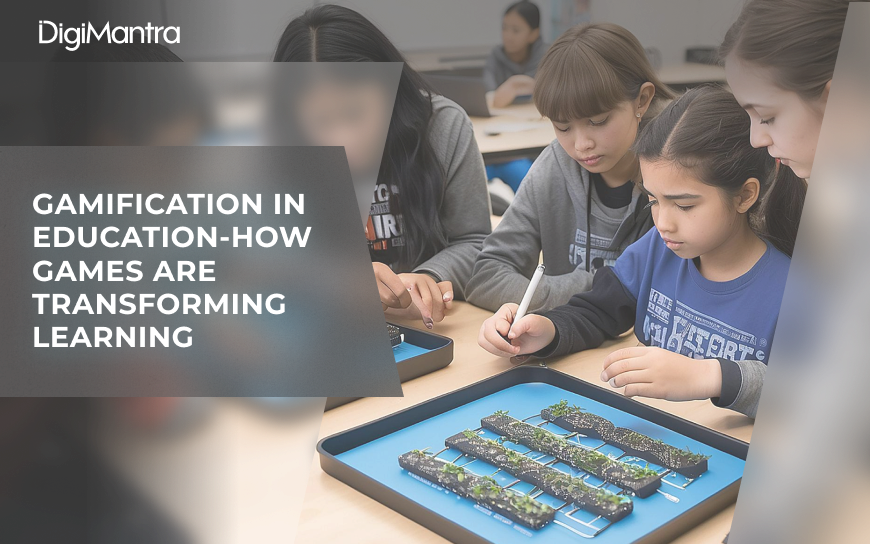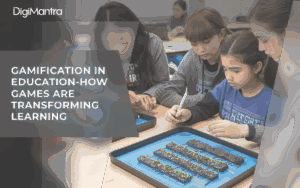When it comes to modern education, one of the biggest challenges teachers face today is keeping students actively engaged in the learning process. With classrooms becoming more diverse and the demand for inclusive education growing stronger, educators are constantly looking for creative ways to make learning more meaningful and exciting.
That’s where gamification in education steps in, a concept that’s transforming how students learn and interact.
By weaving game-like elements into lessons, teachers can turn traditional classrooms into immersive learning experiences. This not only sparks curiosity but also boosts motivation and helps students retain knowledge more effectively.
In this blog, we’ll explore how gamifying education is reshaping interactive teaching, uncover its real-world benefits, and understand why it’s a powerful tool for building a more inclusive and engaging education system.
What Is Gamification in Education?
Gamification in education is the practice of applying game-inspired elements to traditional learning environments to make the process more engaging and rewarding. It’s not about turning every lesson into a video game; it’s about using features like rewards, levels, challenges, and instant feedback to spark motivation and active participation.
This approach taps into students’ natural love for competition and achievement. By introducing systems such as points, leaderboards, or digital badges, educators can transform routine lessons into immersive experiences that encourage progress and persistence. Ultimately, gamification turns learning into an interactive journey, where every step forward feels like a win.
What Are the Key Features of Gamification in Education?
Gamification isn’t just about making learning fun; it’s about designing experiences that actively support how students engage with content. The magic lies in its carefully crafted features, each aimed at boosting motivation, focus, and understanding. Let’s break down the essential elements that make gamified learning so effective:
1. Clear Goals and Guidelines
Every gamified lesson starts with a clear purpose. Students know exactly what they’re aiming for and how to achieve it. Well-defined rules provide structure, keeping learners focused and on track while reducing confusion.
2. Visual Progress Tracking
Whether it’s points, badges, or levels, progress indicators give students a tangible sense of achievement. Seeing how far they’ve come fuels motivation and inspires them to push further.
3. Immediate Feedback
In gamifying education, one of the most powerful tools is instant feedback. Students don’t have to wait for a test result as they get real-time responses, whether it’s a hint, a “try again” prompt, or unlocking the next stage. This helps them learn from mistakes and adjust strategies quickly.
4. Levels and Challenges
Lessons are divided into bite-sized stages, much like levels in a video game. Completing one level unlocks the next, turning learning into an engaging journey. Challenges along the way sharpen critical thinking and problem-solving skills.
5. Rewards and Recognition
From digital badges to classroom privileges, rewards acknowledge effort as much as achievement. In gamifying education, recognizing small wins keeps morale high and encourages continuous participation.
6. Friendly Competition and Collaboration
Leaderboards can spark healthy competition, while team-based challenges foster collaboration. The right mix of both motivates students to excel individually while supporting peers.
7. Personalization and Choice
Many gamified learning platforms let students select avatars, learning paths, or missions. This sense of ownership makes learning personal and immersive, helping students connect more deeply with the material.

What Popular Gamification Techniques are Transforming Classrooms?
Gamification in education has become a go-to strategy for teachers looking to make learning more interactive and enjoyable. By incorporating game-like elements, educators can spark curiosity, encourage participation, and make lessons memorable. Here are some of the most effective techniques being used in classrooms today for gamifying education:
1. Point Systems
Points are a simple yet powerful way to track student effort. Whether for completing assignments, participating in discussions, or showing improvement, points give learners a tangible sense of accomplishment.
2. Leaderboards
Ranking students on leaderboards adds a dash of healthy competition. Seeing how they stack up against peers motivates learners to push their limits while celebrating progress.
3. Badges and Rewards
Visual rewards like badges or stickers mark milestones and achievements. These tokens of recognition boost confidence and encourage consistent engagement.
4. Quests and Challenges
Turning learning goals into quests or challenges transforms ordinary lessons into exciting missions. Students feel a sense of adventure as they work to complete objectives.
5. Levels or Stages
Breaking content into levels or stages gives students a clear path forward. Progressing from one level to the next creates a sense of growth and keeps learners motivated to “level up”.
6. Storytelling
Embedding lessons within a story or narrative makes learning immersive and memorable. When students feel part of an ongoing adventure, their engagement naturally increases.
7. Team-Based Activities
For gamifying education, group challenges and collaborative tasks encourage communication and teamwork. Working together on missions not only reinforces learning but also strengthens social skills.

Top Gamification Learning Platforms and Tools for Educators
In today’s tech-driven classrooms, gamification in education has never been easier to implement. A variety of tools and apps empower teachers to turn learning into an interactive, motivating experience. Here are some of the most popular gamified learning platforms making waves in education:
1. Classcraft
Classcraft transforms classroom behavior and academics into a role-playing game (RPG) adventure. Students earn points for positive actions and progress through levels, making learning both fun and goal-oriented.
2. Kahoot!
Kahoot! is a quiz-based platform where students can answer questions in real time. The competitive, game-show style environment keeps learners engaged and eager to participate.
3. Wayground (formerly Quizizz)
Wayground allows teachers to create interactive quizzes with instant feedback. The gamified format motivates students to learn actively while reinforcing key concepts.
4. Duolingo
Duolingo turns language learning into a game with points, streaks, and levels. Its engaging, bite-sized lessons make mastering a new language feel like an exciting challenge.
5. Minecraft Education Edition
This gamifying education platform uses the popular game Minecraft to spark creativity and critical thinking. Students can explore, build, and solve problems in a safe, educational environment.
6. Edmodo
Edmodo offers badges, leaderboards, and gamified learning communities. It helps students stay motivated while fostering a collaborative online classroom.
7. Seesaw
Seesaw focuses on student-driven digital portfolios. Teachers can assign tasks, track progress, and reward achievements, making learning interactive and personalized.

What are the Powerful Benefits of Gamification in Education?
Gamification in education isn’t just about making lessons fun; it fundamentally transforms the way students engage with content, interact with peers, and approach learning itself. Let’s explore the key advantages that make gamifying education so effective:
1. Boosts Student Engagement
Traditional classroom methods can sometimes struggle to hold students’ attention. Gamification in education changes that by incorporating interactive tools, stories, and visuals that make learning feel exciting. Tasks that resemble games naturally draw students in and keep them focused.
2. Sparks Motivation and Participation
Rewards, achievements, and recognition act as powerful motivators. Even students who are usually hesitant to participate often get more involved when learning feels like a game.
3. Enhances Retention and Recall
Active participation combined with instant feedback helps students remember what they learn. The cycle of practice, reward, and reinforcement strengthens memory and understanding.
4. Encourages Active Learning
Gamified lessons turn students from passive listeners into active problem-solvers. They make decisions, complete missions, and interact with content, deepening comprehension along the way.
5. Supports Goal-Setting and Self-Monitoring
Game elements like progress tracking and levels help students monitor their growth. This encourages self-awareness and empowers them to set personal learning goals.
6. Develops Critical Thinking
Many gamified tasks involve puzzles, challenges, or scenario-based missions that require students to think creatively and apply knowledge in meaningful ways.
7. Promotes Collaboration and Social Learning
Team-based games and group challenges enhance communication and teamwork. Students learn to support one another, share ideas, and value peer contributions, fostering a collaborative learning environment.
8. Builds Confidence and Resilience
Completing goals, even small ones, gives students a sense of accomplishment. When mistakes happen, the game-like setup encourages them to try again without fear, nurturing resilience and perseverance.
What are the Challenges of Implementing Gamification in Education?
While gamification in education offers incredible benefits, it’s not without its hurdles. Educators need to be aware of the potential challenges to ensure it’s used effectively. Here are some of the key obstacles in gamifying education:
1. Time-Intensive Planning
Creating gamified lessons takes careful preparation. Teachers must design game elements, track progress, and make sure each activity aligns with learning goals - all of which can be time-consuming.
2. Technology Access and Skills
Many gamification tools rely on digital devices and stable internet. In low-resource settings, this can be a major limitation. Additionally, not all teachers and students are comfortable navigating technology.
3. Risk of Overemphasizing Rewards
While points, badges, and rewards can boost motivation, they can sometimes overshadow actual learning. Some students may focus more on collecting rewards than truly understanding the material.
4. Pressure from Competition
Leaderboards and rankings can encourage performance, but they can also discourage students who consistently place lower. This may lead to frustration, anxiety, or decreased confidence.
5. Not Ideal for Every Learner
Not all students thrive in gamified environments. Some prefer traditional teaching methods and may feel uncomfortable with game-based tasks or competition. Flexibility is key to accommodating different learning styles.
6. Maintenance and Tracking Challenges
Not all students thrive in gamified environments. Some prefer traditional teaching methods and may feel uncomfortable with game-based tasks or competition. Flexibility is key to accommodating different learning styles.
7. Fit with the Curriculum
Not every subject or topic lends itself easily to gamification. Complex or abstract concepts may still require conventional teaching methods to ensure comprehension.
Despite these challenges, with thoughtful planning and a balanced approach by a reliable digital transformation company, gamification in education can still be a powerful tool, making lessons more interactive, engaging, and effective for a wide range of students.

Gamification in Education: Eye-Opening Statistics
The impact of gamification in classrooms is more than just anecdotal. Research shows it’s driving real results in student engagement and learning outcomes. Here’s what the data reveals:
- Boosted Engagement: A report by EdTech Digest found that 89% of educators noticed higher student engagement when incorporating gamified tools into their lessons.
- Improved Performance: According to eLearning Industry, students learning in gamified environments perform 14% better on skill-based assessments compared to traditional methods.
- Enhanced Knowledge Retention: Research from the University of Colorado shows that gamification in education can increase knowledge retention by up to 40%, helping students remember what they learn more effectively.
- Increased Motivation: Surveys indicate that over 70% of students feel more motivated to learn when lessons include game-like elements, making learning an enjoyable and rewarding experience.
Gamification vs. Game-Based Learning: What’s the Difference?
Gamification in education and game-based learning are often used interchangeably, but they serve different purposes in education. Understanding the distinction can help educators choose the right approach for their classroom. Here’s a breakdown:
| Aspect | Gamification in Education | Game-Based Learning |
|---|---|---|
| Definition | Integrates game elements into non-game activities | Uses full-fledged games as part of the learning process |
| Purpose | To boost motivation and engagement | To teach content through immersive gameplay |
| Examples | Points, badges, leaderboards | Educational board games, simulations |
| Learning Focus | Rewards, progression, and student involvement | Problem-solving, strategy, and content mastery |
| Flexibility | Can be added to almost any subject or lesson | Often requires specific games or content alignment |
| Popular Tools | Kahoot!, ClassDojo, Quizizz | Minecraft Education Edition, SimCityEDU, Duolingo |
In short, gamification in education enhances traditional lessons with game-like rewards and progression, while game-based learning immerses students directly in educational games to teach concepts and skills. Both approaches can make learning more interactive, but choosing the right one depends on your goals and classroom setup.

Final Thoughts
Gamification in education isn’t just a passing trend; it’s rather a transformative approach that can make learning exciting, motivating, and deeply engaging. When thoughtfully woven into lesson plans, it shifts students from passive observers to active participants, encouraging them to take ownership of their learning journey.
That said, gamification works best when the focus stays on meaningful learning, rather than just collecting points or rewards. Striking the right balance ensures that games and challenges enhance understanding, critical thinking, and collaboration.
When guided by a trusted digital transformation company, gamifying education can turn classrooms into dynamic, playful environments where students are inspired to learn, grow, and “level up” every day. It’s more than fun as it’s a pathway to deeper engagement and lasting success.
If you’re curious to explore the exciting world of gamified learning platforms and shape the future of learning, partner with DigiMantra’s experts today and turn your vision to life with our professional education app development services.
Unlock Your Digital Potential Today!
Don’t just keep up, lead your industry.
Connect with DigiMantra’s top strategists and AI, web, and software experts to boost growth, streamline operations, and drive innovation.
Your transformation starts here.





